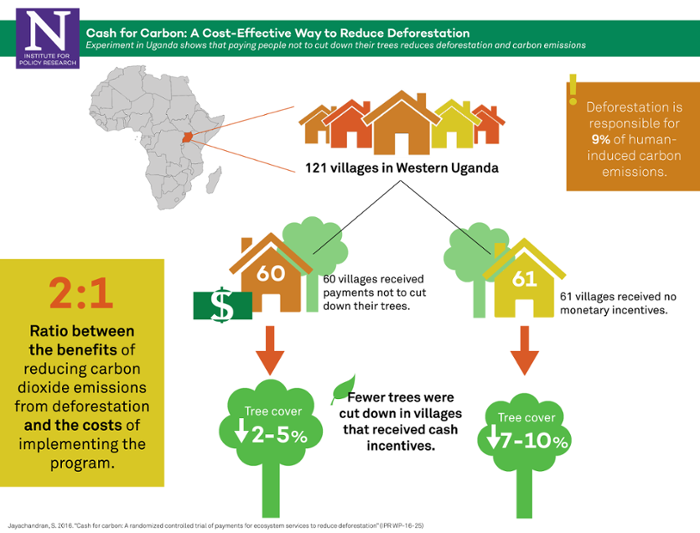Infographic: Cash for Carbon
Experiment in Uganda shows that paying people not to cut down their trees is a cost-effective way to carbon emissions
Get all our news
Click on the image above to see a larger version of the infographic.
Deforestation accounts for an estimated 9 percent of human-induced carbon emissions. In recent years, programs have been implemented to slow deforestation in developing countries, where the majority of global deforestation occurs. Yet little is known about whether such programs are effective.
A recent study in Uganda, led by IPR development economist Seema Jayachandran and her colleagues, suggests that paying people to conserve their trees could be a highly cost-effective way to reduce deforestation, and therefore carbon emissions.
The researchers conducted a randomized controlled trial in 121 villages in western Uganda over a two-year period. In 60 villages, forest owners received payments not to cut down their trees; people in the other 61 villages received no monetary incentives.
Using high-resolution satellite imagery to compare tree cover in the villages, Jayachandran and her colleagues find that forest cover declined by just 2-5 percent in villages that received payments. For villages not enrolled in the payment program, forest cover fell by 7-10 percent, meaning fewer trees were cut down when payments were offered.
Not only did the program effectively reduce deforestation—it was very cost-effective. The researchers estimate nearly a 2:1 ratio between the benefits of preventing carbon dioxide emissions from deforestation and implementation costs.
This finding highlights the advantages of focusing on developing countries when working to reduce global carbon emissions. While the benefit of conserving a tree is the same regardless of the location, paying individuals to conserve forests in developing countries like Uganda is less expensive, making it cheaper to reduce overall emissions.
Today, with deforestation accounting for a substantial portion of human-induced carbon emissions, the researchers describe the payment program they studied as “a cost-effective way to avert deforestation in developing countries—and hence a powerful tool to mitigate climate change.”
Seema Jayachandran is associate professor of economics and an IPR fellow.
Published: April 28, 2017.
